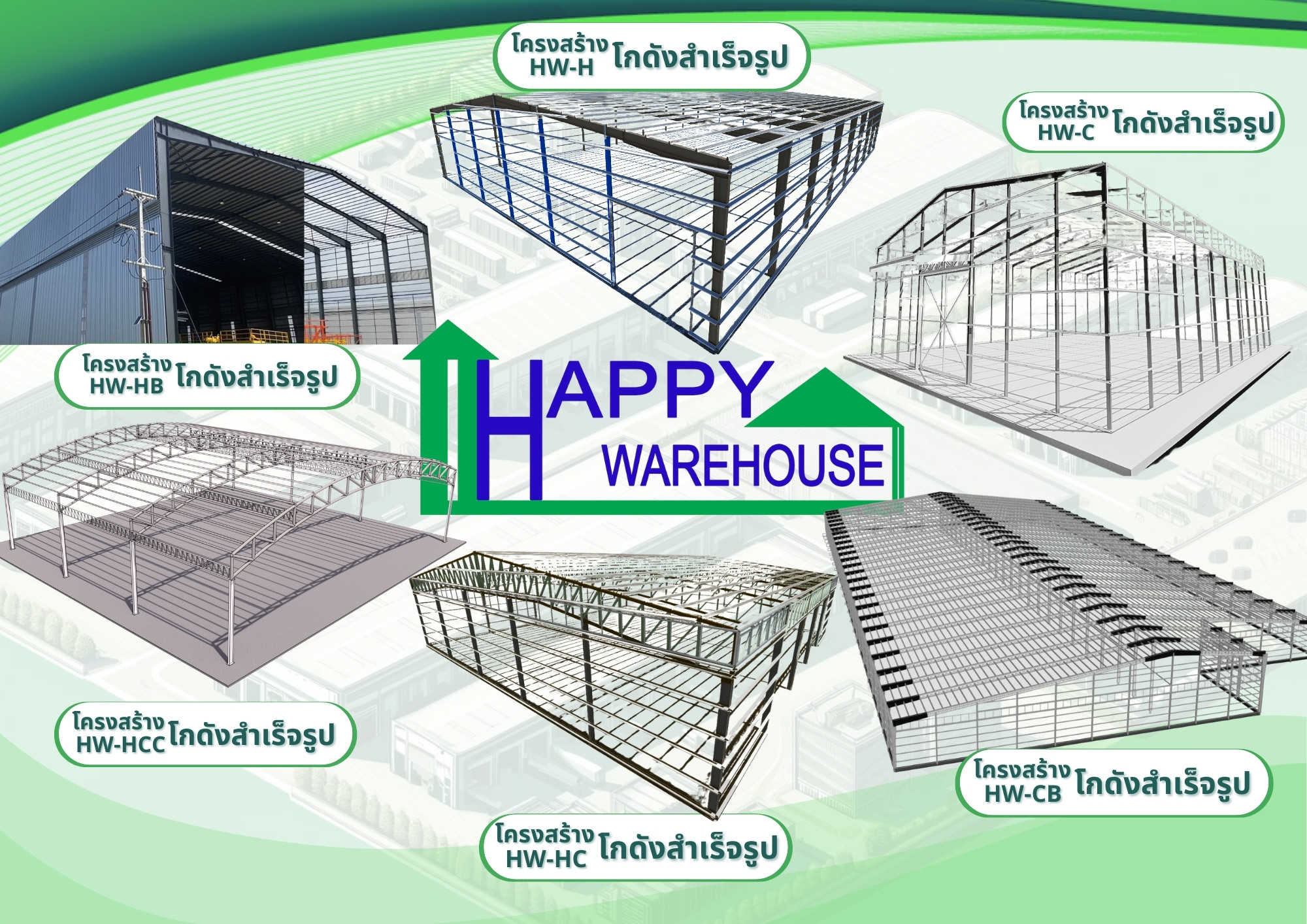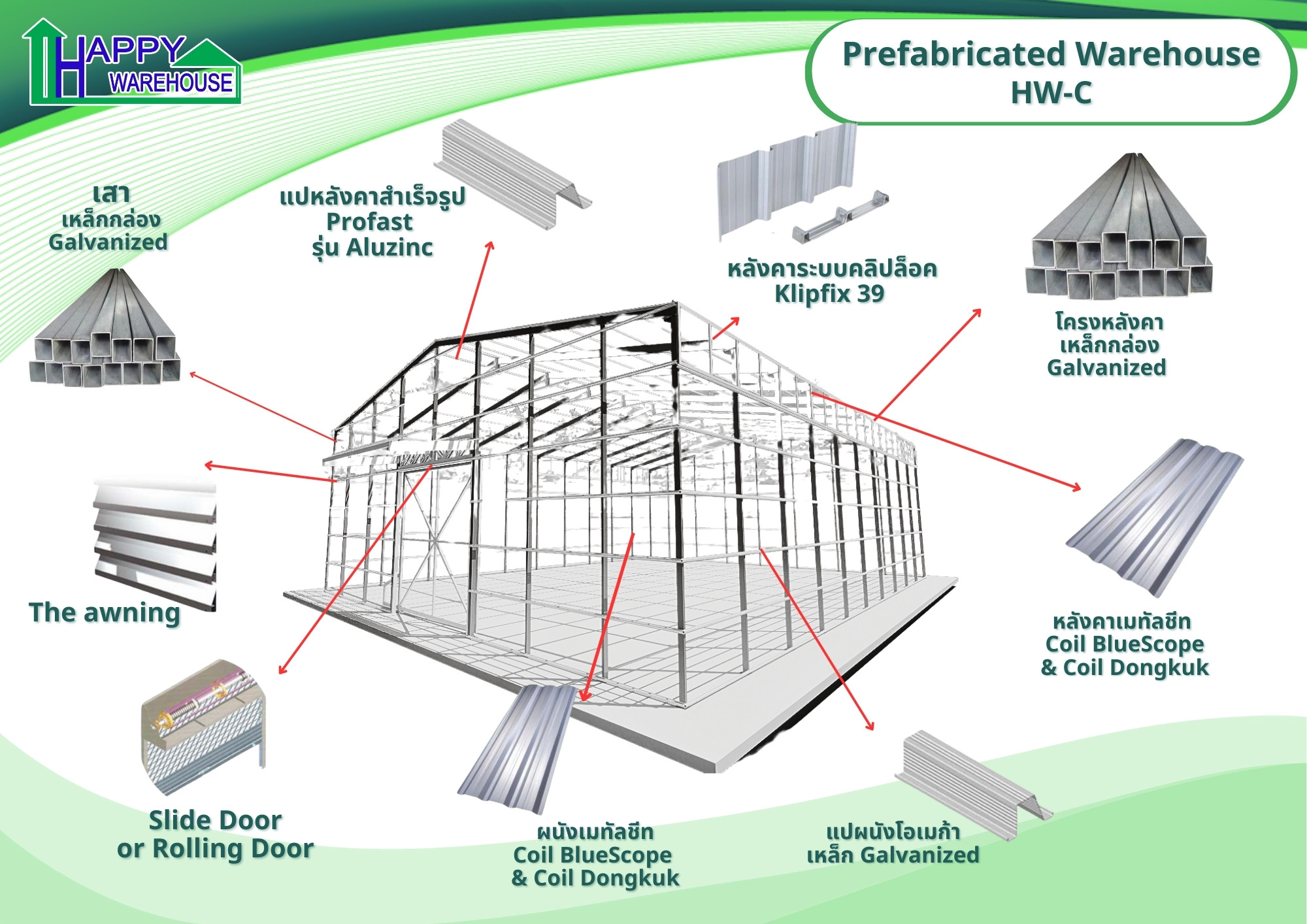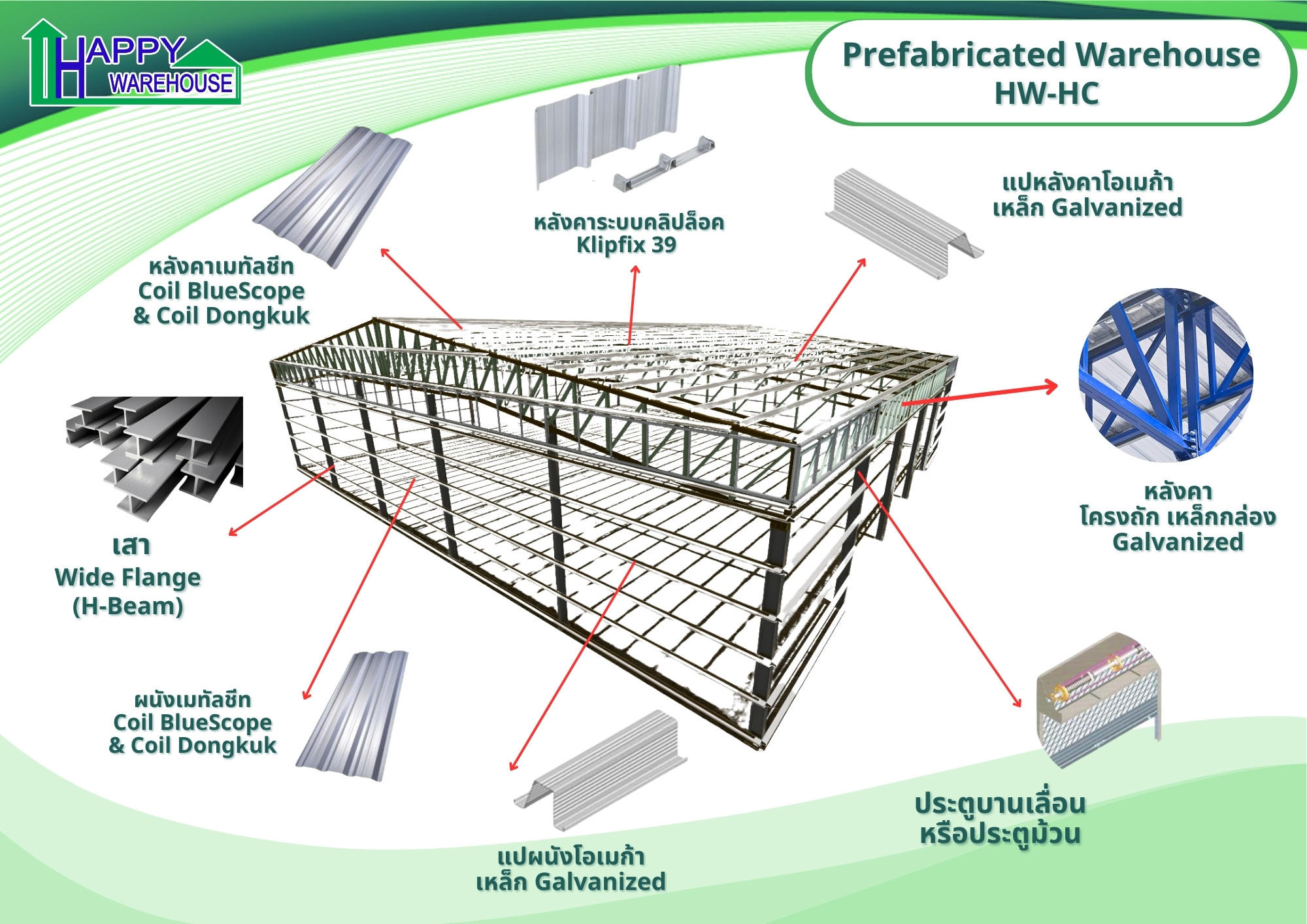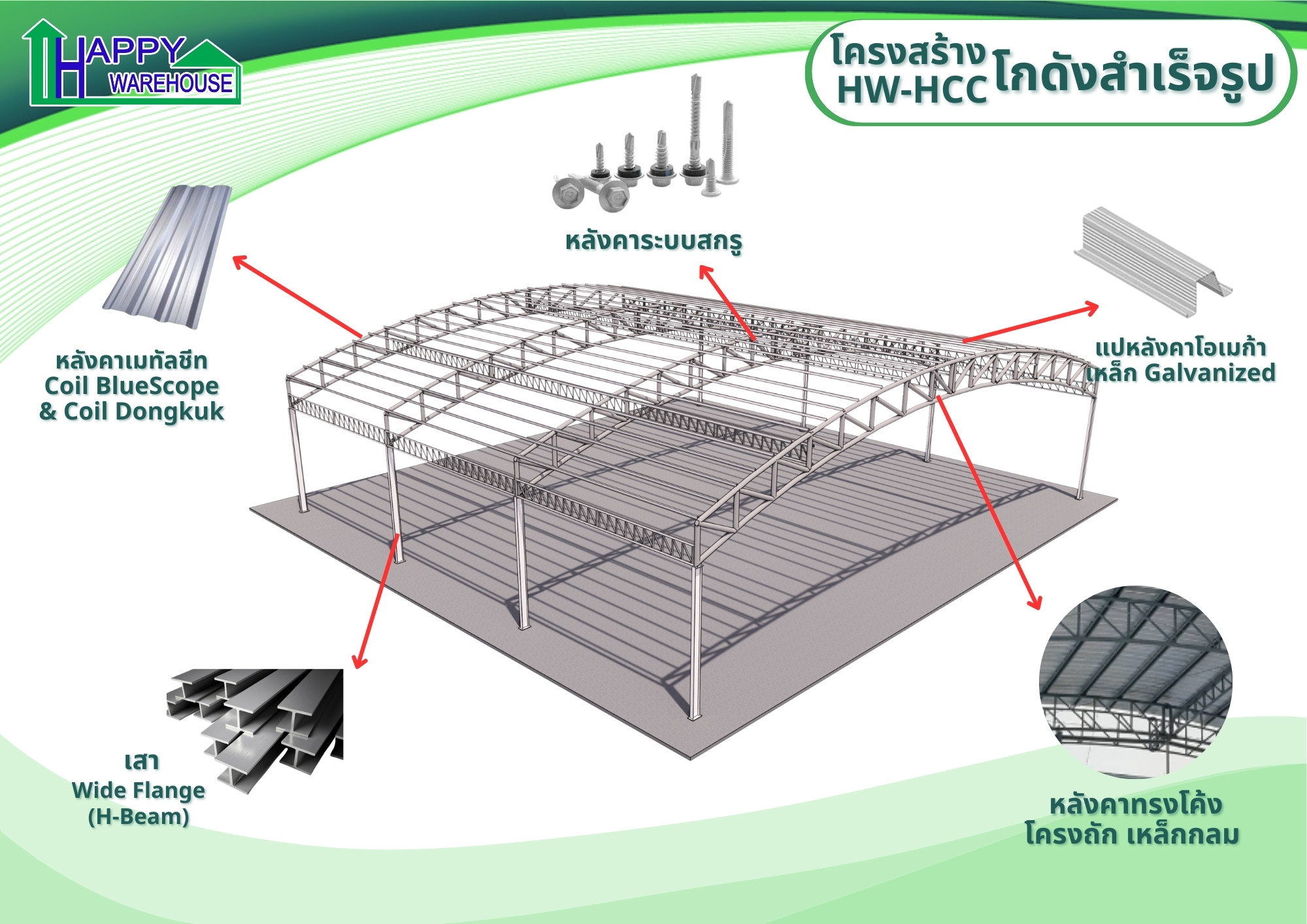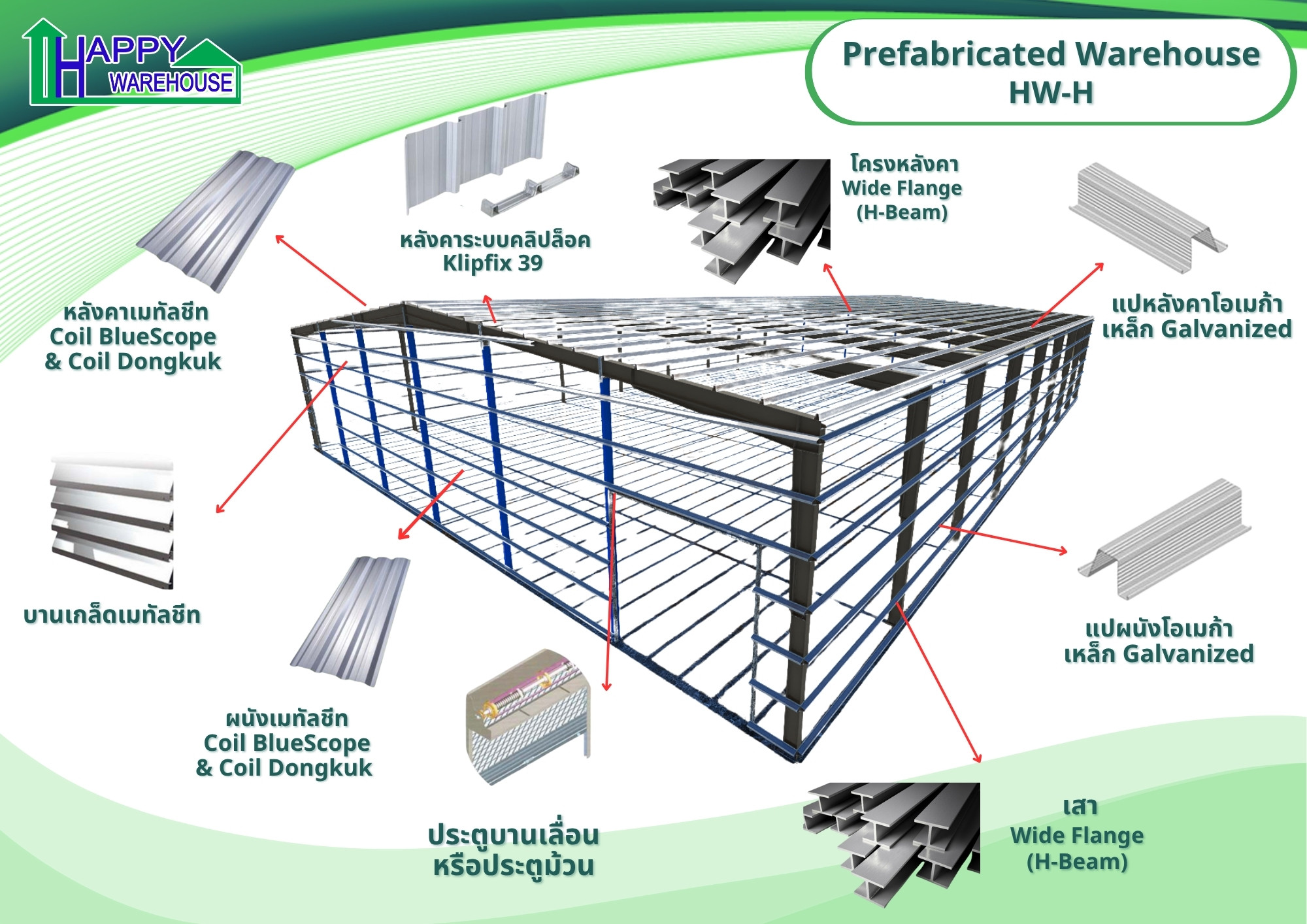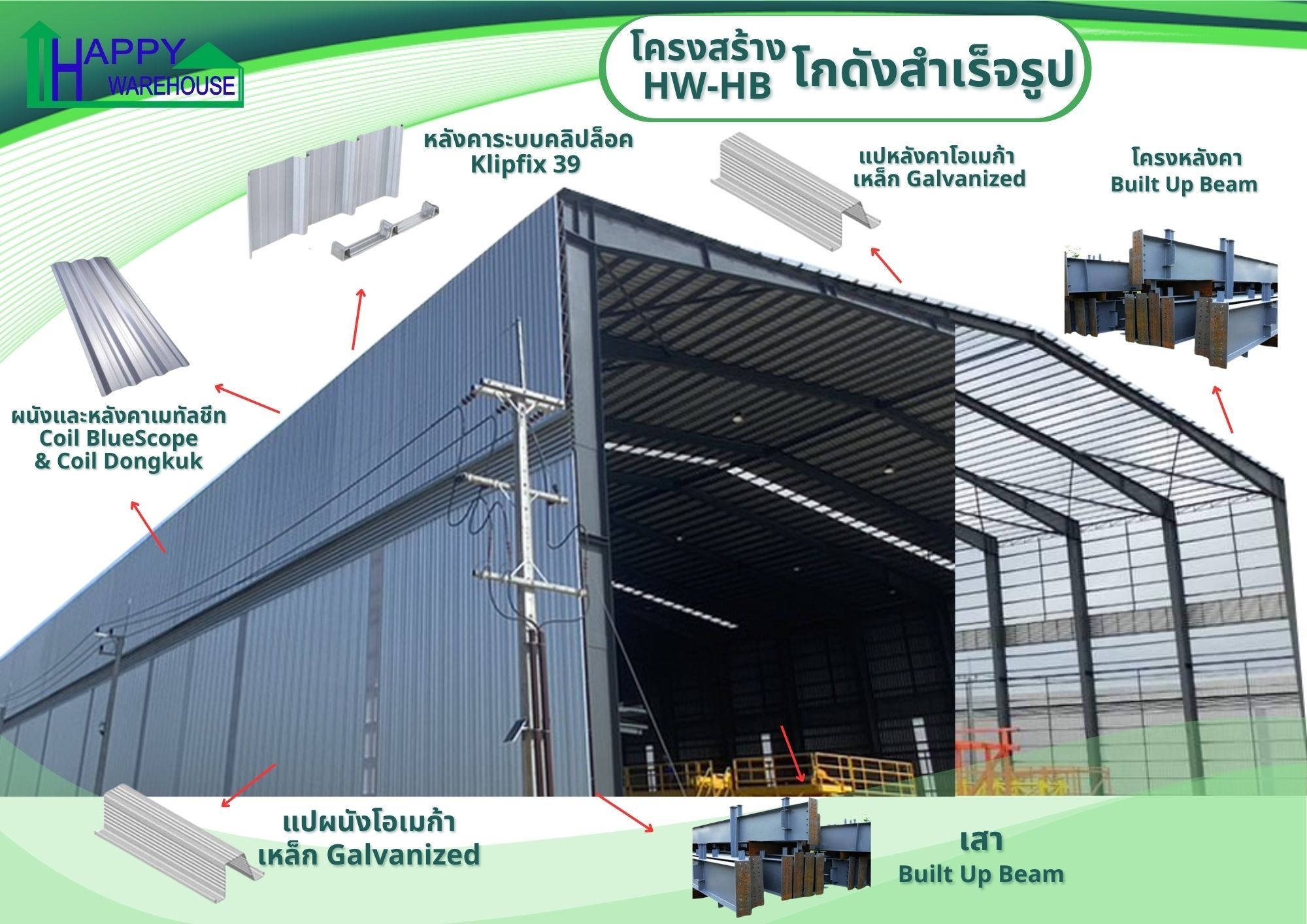- หน้าแรก
- HWโกดังสำเร็จรูป
สร้างโกดังสำเร็จรูป ไม่ยากอย่างที่คิด
Happy Warehouse ผู้นำด้านระบบการก่อสร้างโกดังสำเร็จรูป อันดับ 1 ของเมืองไทย
ดูแลทุกขั้นตอน ตั้งแต่วางแผน ออกแบบ ก่อสร้าง ไปจนถึงส่งมอบ
พร้อมควบคุมงบประมาณแบบมืออาชีพ สร้างไว ไม่ต้องรอนาน ได้มาตรฐานตามหลักวิศวกรรม
ไม่ว่าจะโครงสร้างโกดังสำเร็จรูป โรงงาน และอาคารขนาดใหญ่ เราสร้างให้ได้แบบมืออาชีพ
เราสร้างให้ได้แบบมืออาชีพ ควบคุมต้นทุนได้ไม่เสี่ยงงบบานปลาย ตอบโจทย์ทุกธุรกิจ
บริการของเรา
- รับปรึกษาและวางแผนการสร้างโกดัง
เราเริ่มจากการให้คำปรึกษาอย่างละเอียดโดยทีมวิศวกรมืออาชีพ ซึ่งจะช่วยวิเคราะห์ความต้องการ งบประมาณ และพื้นที่ก่อสร้าง เพื่อออกแบบโกดังให้ตรงจุด พร้อมวางแผนร่วมกับลูกค้าตั้งแต่ต้นจนส่งมอบ ทำให้ไม่ต้องกังวลเรื่องการประสานงานหลายฝ่าย โดยระหว่างกระบวนการออกแบบจะมีการประเมินค่าใช้จ่ายและงบประมาณเป็นระยะ เพื่อควบคุมให้อยู่ในเป้าหมายที่วางไว้
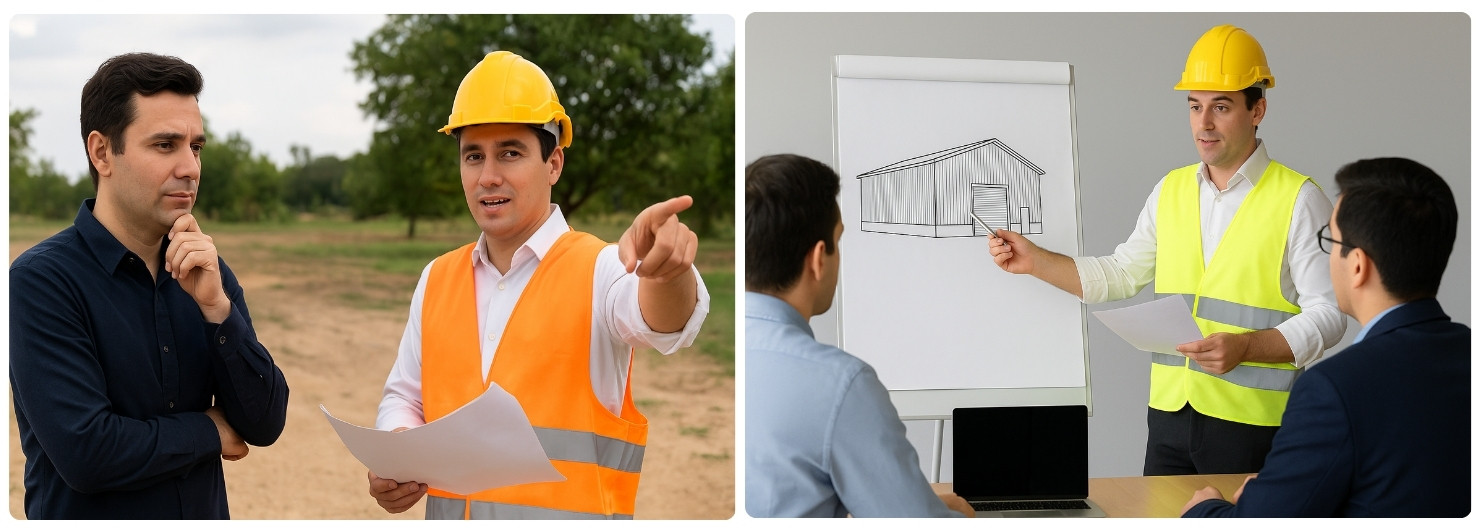
- รับออกแบบโกดังโดยวิศวกรและสถาปนิกมืออาชีพ
เราให้บริการออกแบบโกดังให้ตรงตามลักษณะการใช้งาน ไม่ว่าจะเป็นโกดังเก็บสินค้า โกดังโลจิสติกส์ หรือโกดังโรงงานผลิต พร้อมแบบโครงสร้างและสถาปัตยกรรมที่รองรับมาตรฐานวิศวกรรม รองรับน้ำหนักการใช้งานจริง และสามารถปรับแบบให้เหมาะกับธุรกิจของคุณได้ทุกรูปแบบ โดยเน้นความแข็งแรงตามมาตรฐานวิศวกรรมสถานแห่งประเทศไทย ควบคู่กับการเลือกใช้วัสดุอย่างเหมาะสม เพื่อหลีกเลี่ยงการโอเวอร์ดีไซน์ที่อาจทำให้ต้นทุนสูงเกินจำเป็น

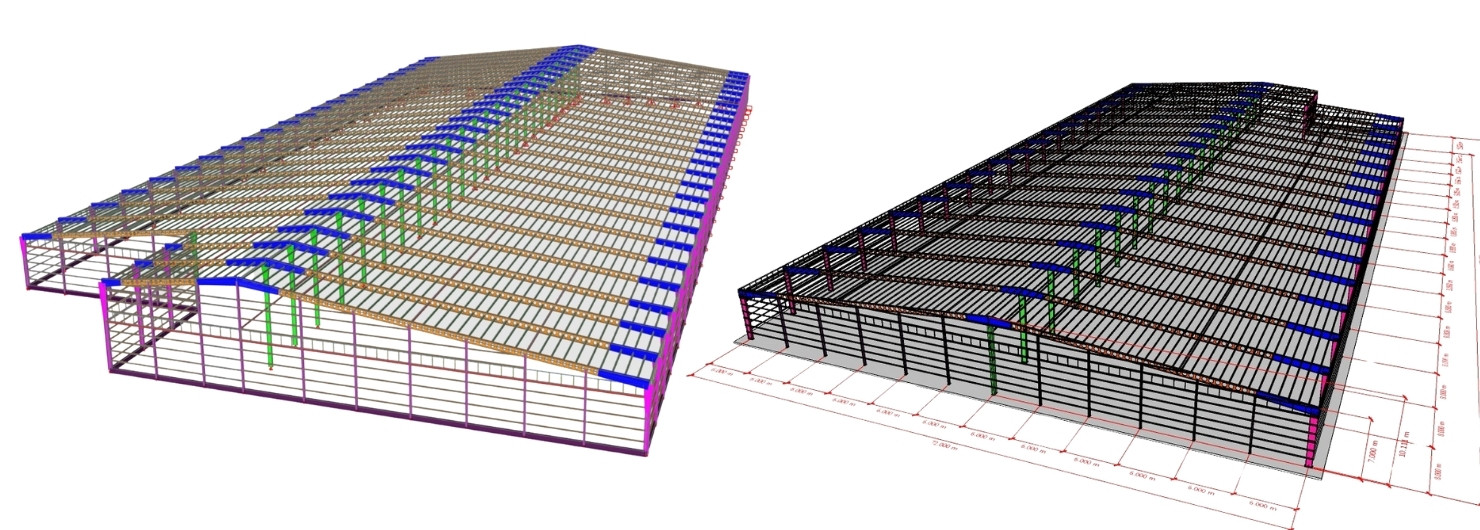
- รับสร้างงานพื้นและฐานราก
จุดแข็งสำคัญของเราคือ โรงหล่อชิ้นส่วน Precast สำเร็จรูป ซึ่งช่วยให้สามารถควบคุมคุณภาพของคอนกรีตได้ 100% ลดความล่าช้า และสามารถผลิตชิ้นส่วนคอนกรีตสำเร็จรูป แข็งแรง และรวดเร็ว อาทิเช่น คาน เสา ตอม่อ เข็ม ผนังสำเร็จรูป กำแพงกันดิน รั้วสำเร็จรูป เป็นต้น

- รับผลิตชิ้นส่วนโครงสร้างสำเร็จรูปที่โรงงานของเราเอง
โรงงานของเราผลิตชิ้นส่วนโครงสร้างเหล็กสำเร็จรูปหลากหลายประเภท ทั้งโครงหลังคา เสา คาน แป และผนัง ด้วยเทคโนโลยีที่ทันสมัยเพื่อความแม่นยำสูงสุด ทำให้สามารถควบคุมมาตรฐานการผลิตได้อย่างเข้มงวด และจัดส่งตรงถึงไซต์งานได้อย่างมีประสิทธิภาพ และมาพร้อมกับความเชื่อมั่นด้านคุณภาพจากประสบการณ์การผลิตในโรงงานกว่า 10 ปี

- ติดตั้งรวดเร็ว ปลอดภัย ด้วยทีมงานมืออาชีพ
เมื่อชิ้นส่วนโครงสร้างจากโรงงานถูกจัดส่งถึงหน้างาน ทีมติดตั้งของเราจะดำเนินการอย่างมืออาชีพด้วยระบบ Prefabrication nut & bolt ที่ช่วยให้การก่อสร้างโกดังเสร็จรวดเร็วภายใน 30 - 60 วัน ลดทั้งเวลาและค่าใช้จ่าย พร้อมรองรับการต่อเติมและฟังก์ชันการใช้งานที่หลากหลาย ไม่ว่าจะเป็นการติดตั้งเครน ชั้นลอย ออฟฟิศ ระบบไฟฟ้า และระบบระบายอากาศ โดยสามารถเลือกได้ทั้งแบบมาตรฐานสำเร็จรูป หรือแบบออกแบบใหม่ทั้งหมดตามความต้องการเฉพาะของลูกค้า
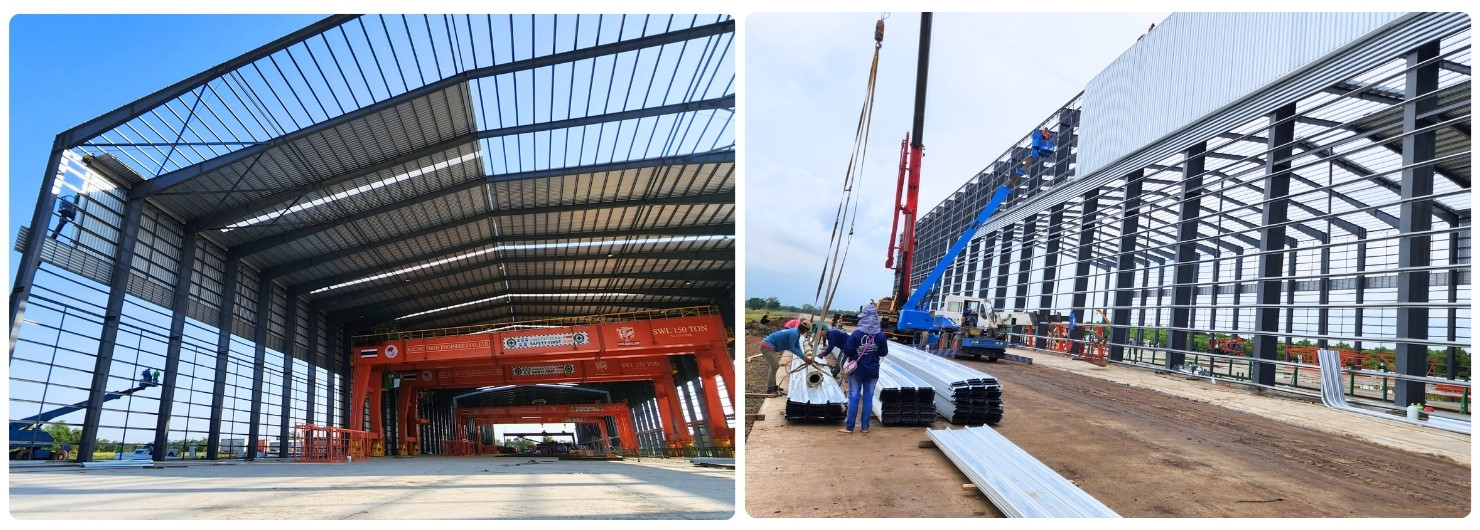

- บริการหลังการขาย
เราจะทำการส่งมอบโกดังที่พร้อมใช้งานทันที มั่นใจได้ด้วยการรับประกันโครงสร้างนานถึง 10 ปี และบริการหลังการขายที่ชัดเจน พร้อมทีมวิศวกรผู้เชี่ยวชาญคอยตรวจสอบคุณภาพหน้างานในทุกขั้นตอน รวมถึงให้คำปรึกษาหลังการติดตั้งอย่างต่อเนื่อง เพื่อให้ลูกค้าได้รับความมั่นใจสูงสุดในการใช้งาน เพราะที่ Happy Warehouse เราไม่ได้ขายแค่งานก่อสร้าง แต่เราขาย "ระบบโครงสร้างที่พร้อมใช้ได้ทันที" ด้วยความยืดหยุ่นสูงในการออกแบบเฉพาะให้ตรงกับความต้องการของลูกค้า ผสานกับความเชื่อมั่นด้านคุณภาพจากประสบการณ์การผลิตมากกว่า 10 ปี
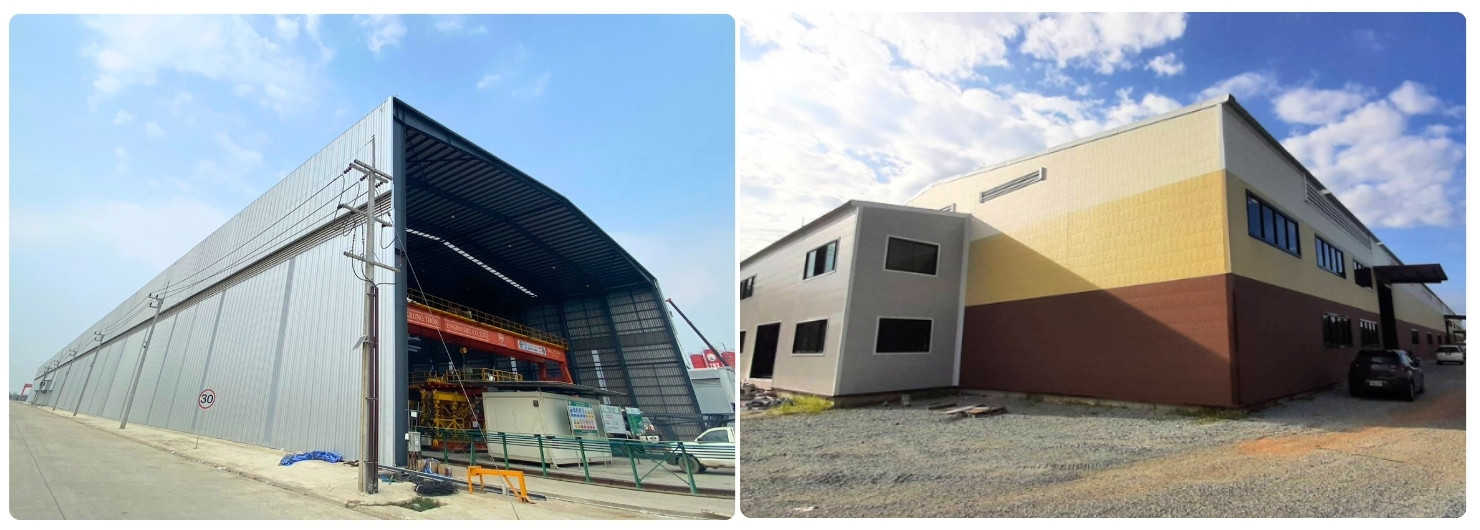

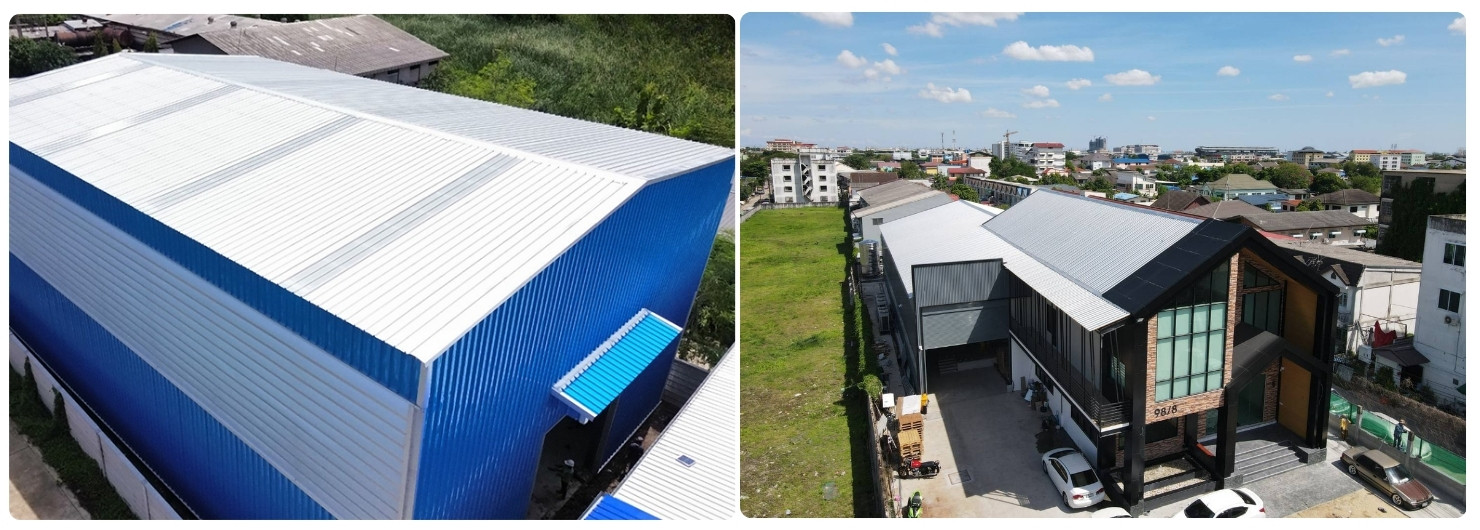

loading...
โอนเงินชำระค่าสินค้าได้ที่เลขที่บัญชี
090-105122-4 ธนาคารกสิกรไทย
ชื่อบัญชี บริษัท มีสุข คอร์ปอเรชั่น (2006) จำกัด
หากท่านชำระค่าสินค้าเรียบร้อยแล้วสามารถแจ้งหลักฐานการชำระค่าสมัครให้กับเจ้าหน้าทีเพื่อทำการตรวจสอบได้ตามช่องทางดังนี้
อีเมล : cs@me-suk.com
Line ID : @happyfranchise
โทรศัพท์ : 095-772-3902 , 0-2426-2625 กด 5

ชำระเงิน

แจ้งชำระเงิน

